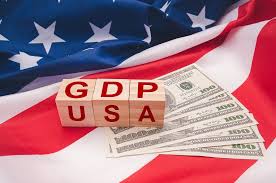US Economy Expands 3% in the 2nd Quarter

The U.S. economy has shown a robust performance in the second quarter of this year, expanding by 3%. This growth is seen as a strong indicator of the country’s economic resilience, especially in the face of various global challenges. Let’s dive into the details of this expansion and what it means for the future.
Understanding the 3% Growth Rate
What Does 3% Growth Mean?
A 3% growth rate in the GDP is a significant achievement, indicating that the economy is growing at a healthy pace. This rate of expansion suggests that businesses are thriving, consumer spending is up, and overall economic activity is robust.
How is GDP Growth Measured?
Gross Domestic Product (GDP) is the total value of goods and services produced in a country. It’s a broad measure of overall economic activity. A 3% growth in GDP means that the economy has produced 3% more goods and services than it did in the previous quarter.
Factors Driving the Growth
Consumer Spending
One of the primary drivers of this growth is consumer spending. When people spend more money on goods and services, businesses thrive, which in turn boosts the economy. In this quarter, consumer spending has been particularly strong in sectors like retail and services.
Business Investments
Another critical factor is business investments. Companies are investing more in equipment, technology, and infrastructure, which is a positive sign for future growth. These investments not only boost current economic activity but also lay the groundwork for continued expansion.
Government Spending
Government spending also plays a crucial role in economic growth. Increased spending on infrastructure, defense, and public services has contributed to the GDP growth this quarter.
Impact of Global Factors
International Trade
The global economy has a direct impact on the U.S. economy. In this quarter, international trade has been a mixed bag. While exports have increased, imports have also risen, which slightly offsets the growth from exports. However, the overall impact has been positive.
Global Economic Conditions
Global economic conditions, including the performance of major economies like China and the European Union, also influence U.S. economic growth. A stable global economy generally supports growth in the U.S.
Challenges to Sustaining Growth
Inflation Concerns
One of the biggest challenges to sustaining this growth is inflation. As the economy grows, prices tend to rise, which can erode purchasing power and slow down economic activity.
Interest Rate Hikes
To combat inflation, the Federal Reserve may increase interest rates. While this can help control inflation, it also makes borrowing more expensive, which can slow down investment and spending.
Supply Chain Disruptions
Ongoing supply chain disruptions, partly due to global events like the pandemic, continue to pose a risk to economic growth. These disruptions can lead to shortages of goods and higher prices, which can dampen economic activity.
The Role of Technology in Economic Growth
Technological Advancements
Technological advancements have been a significant driver of economic growth. Innovations in fields like artificial intelligence, renewable energy, and digital services have boosted productivity and efficiency across various sectors.
Digital Transformation
The digital transformation of businesses has also played a crucial role. Companies that have embraced digital tools and technologies have been able to adapt to changing market conditions more effectively, driving economic growth.
The Outlook for the U.S. Economy
Predictions for the Next Quarter
Looking ahead, economists are cautiously optimistic about the U.S. economy. While challenges like inflation and supply chain disruptions remain, the underlying fundamentals are strong. If consumer spending and business investments continue to grow, we could see similar growth in the next quarter.
Long-Term Growth Prospects
In the long term, the U.S. economy is expected to continue growing, although the rate of growth may fluctuate. Key factors that will influence long-term growth include technological advancements, global economic conditions, and domestic policies.
The Importance of Economic Diversification
Diversifying Economic Activities
To sustain long-term growth, it’s essential for the economy to be diversified. This means having a variety of industries that contribute to GDP, rather than relying too heavily on any single sector.
The Role of Small Businesses
Small businesses play a crucial role in economic diversification. By fostering entrepreneurship and supporting small businesses, the U.S. can ensure that its economy remains resilient and adaptable.
The 3% expansion of the U.S. economy in the second quarter is a positive sign, reflecting the resilience and adaptability of the American economy. However, challenges like inflation, interest rate hikes, and supply chain disruptions need to be managed carefully to sustain this growth. As we look ahead, the focus should be on fostering innovation, supporting small businesses, and maintaining a diversified economy to ensure continued prosperity.



